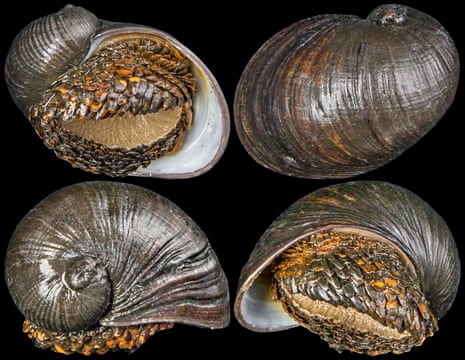A golden snail with a foot clad in iron scales seems like a creature from science fiction. But in a few remote spots of the Indian Ocean these snails are very real.
“It looks like an armoured knight crawling around on the deep-sea floor,” says Julia Sigwart, a biologist at Frankfurt’s Senckenberg Research Institute and one of the only people to have seen a living scaly-foot snail (Chrysomallon squamiferum), also known as a sea pangolin.
The snails’ habitat is extreme. They live several miles below the ocean surface on searing hydrothermal vents, which are bathed in toxic chemicals and can reach temperatures of more than 300C (572F).
Q&AWhat is the Discovered in the deep series?
Show
The ocean is one of the world’s last truly wild spaces. It teems with fascinating species that sometimes seems to border on the absurd, from fish that look up through transparent heads to golden snails with iron armour. We know more about deep space than deep oceans, and science is only beginning to scratch the surface of the rich variety of life in the depths.
As mining companies push to industrialise the sea floor and global leaders continue to squabble over how to protect the high seas, the Guardian's Seascape series, Discovered in the deep, will profile some of the most recently discovered weird, wonderful, majestic, ridiculous, hardcore and mind-blowing creatures. They reveal how much there is still to learn about the least known environment on Earth – and how much there is to protect.
The snails’ entire bodies and lifestyles revolve around bacteria growing inside a special pouch in their throat, which convert chemicals pouring out of the vents into energy and thereby provide all the snails’ food.
To keep their microbes well fed, scaly-foot snails evolved enormous gills to absorb oxygen and chemicals from seawater, then deliver it by way of their bloodstream and a hugely capacious heart. A human heart of equivalent proportions would be the size of our heads.
In 2019, scientists worked out that the scales on the snails’ foot are not to protect against predatory attack but to avert a toxic threat that comes from within. The bacteria stashed in a scaly-foot snail’s throat release sulphur as a waste product, which is deadly to snails (it’s a common active ingredient in slug and snail-killing pellets).
The internal structure of their scales acts as tiny exhaust pipes, drawing the dangerous sulphur away from the snails’ soft tissues and depositing it as a harmless iron-based compound on the outside.
Even though they evolved many strange adaptations to survive on vents, scaly-foot snails did not bank on humans showing an interest in their habitat. All three sites where they live – an area of less than 0.025 sq km (0.01 sq miles), which together would fit inside St Peter’s Square in Vatican City – are potential targets for deep-sea mining.

Mining firms are after the gold, silver and other precious or rare metals deposited in the rocky walls of the black smoker chimneys. If their tiny areas of habitat are damaged or destroyed, the scaly-foot snails would soon be gone.
That’s why Sigwart and her team set about assessing the status of these rare animals and eventually had the scaly-foot snail added to the International Union for the Conservation of Nature’s red list as an endangered species.
“It’s an incredibly powerful communication tool,” she says. “When you say a species is endangered, everyone in the world understands that.”
The scaly-foot snail was the first species in the world to be listed as threatened because of deep-sea mining but there are now many deep-sea molluscs that experts have assessed and added to the global endangered list.
Out of 184 endemic species that only live on vents, from giant clams to a fuzzy snail named after Joe Strummer from the Clash, only 25 are not considered to be at risk of extinction.
These species remain relatively secure, Sigwart explains, because they live on vent fields where there is an explicit ban on any future development of deep-sea mining. This includes marine protected areas in territorial waters of Canada and around the Azores.
Most of the other species live on hydrothermal vents out in the high seas, which are beyond territorial limits and therefore less protected and more open to mining exploration.
“These are the red-list assessments that reflect the status and the risk to the whole species and its potential to actually go extinct and for us to lose it completely,” says Sigwart, “and nobody wants that.”
To Sigwart, these unusual molluscs brilliantly illustrate how evolution is just about being good enough to get by. “It shows us the strange and twisted paths that life can take in order to adapt and survive,” she says.
